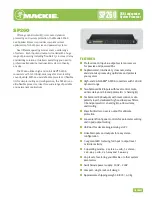
Rev. 1.0, 09/02, page 326 of 568
14.5
Multiprocessor Communication Function
Use of the multiprocessor communication function enables data transfer between a number of
processors sharing communication lines by asynchronous serial communication using the
multiprocessor format, in which a multiprocessor bit is added to the transfer data. When
multiprocessor communication is performed, each receiving station is addressed by a unique ID
code. The serial communication cycle consists of two component cycles; an ID transmission cycle
that specifies the receiving station, and a data transmission cycle. The multiprocessor bit is used to
differentiate between the ID transmission cycle and the data transmission cycle. If the
multiprocessor bit is 1, the cycle is an ID transmission cycle; if the multiprocessor bit is 0, the
cycle is a data transmission cycle. Figure 14.10 shows an example of inter-processor
communication using the multiprocessor format. The transmitting station first sends the ID code
of the receiving station with which it wants to perform serial communication as data with a 1
multiprocessor bit added. It then sends transmit data as data with a 0 multiprocessor bit added.
When data with a 1 multiprocessor bit is received, the receiving station compares that data with its
own ID. The station whose ID matches then receives the data sent next. Stations whose IDs do not
match continue to skip data until data with a 1 multiprocessor bit is again received.
The SCI uses the MPIE bit in SCR to implement this function. When the MPIE bit is set to 1,
transfer of receive data from RSR to RDR, error flag detection, and setting the SSR status flags,
RDRF, FER, and ORER to 1, are inhibited until data with a 1 multiprocessor bit is received. On
reception of a receive character with a 1 multiprocessor bit, the MPB bit in SSR is set to 1 and the
MPIE bit is automatically cleared, thus normal reception is resumed. If the RIE bit in SCR is set to
1 at this time, an RXI interrupt is generated.
When the multiprocessor format is selected, the parity bit setting is rendered invalid. All other bit
settings are the same as those in normal asynchronous mode. The clock used for multiprocessor
communication is the same as that in normal asynchronous mode.
Summary of Contents for H8S/2627
Page 22: ...Rev 1 0 09 02 page xx of xxxvi Index 565 ...
Page 30: ...Rev 1 0 09 02 page xxviii of xxxiv ...
Page 36: ...Rev 1 0 09 02 page xxxiv of xxxiv Table 23 9 Flash Memory Characteristics 561 ...
Page 82: ...Rev 1 0 09 02 page 46 of 568 ...
Page 88: ...Rev 1 0 09 02 page 52 of 568 ...
Page 98: ...Rev 1 0 09 02 page 62 of 568 ...
Page 156: ...Rev 1 0 09 02 page 120 of 568 ...
Page 390: ...Rev 1 0 09 02 page 354 of 568 ...
Page 480: ...Rev 1 0 09 02 page 444 of 568 ...
Page 512: ...Rev 1 0 09 02 page 476 of 568 ...
Page 528: ...Rev 1 0 09 02 page 492 of 568 ...
Page 580: ...Rev 1 0 09 02 page 544 of 568 ...















































